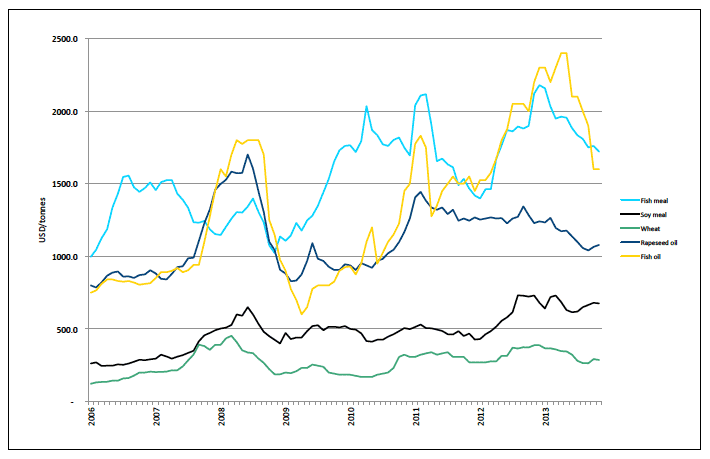MGSA Science & Research Working Group - Aquaculture Science & Research Strategy
MGSA S&RWG was tasked to produce a comprehensive research strategy prioritised on respective contribution to informing the sustainable growth of the Scottish aquaculture industry and potential impacts of the 2020 sustainable production targets as detailed
01 Nutrition
Aquaculture nutrition is a core driver in the sustainable development of the Scottish finfish aquaculture industry, with feed representing approximately 50% of production costs for salmon and trout. Historically the feed sector has been a major user of marine derived fish meal ( FM) and fish oil ( FO). However, the exploitation of these limited marine raw materials is no longer sustainable. If Scotland is to expand its aquaculture industry to meet the sustainable growth target set for finfish of 210,000 tonnes by the year 2020, there is an urgent need to develop alternative, sustainable, secure and affordable feed materials to increase choice and quality to the aquafeed industry.
Since 1995 the use of marine derived feed materials in aqua feeds has already decreased significantly from approximately 82% to 36% in 2012 in favour of vegetable derived proteins and oils. However there are still further possibilities to help reduce the volatility in cost of feed and supply associated with dependence on FM and FO or reliance on imported vegetable protein materials ( Figure 5). These potential cost savings would be passed on throughout the supply chain, ensuring the industry is better able to remain competitive with other farmed fish producing countries. The reduced reliance of marine derived protein and oils for locally sourced feed materials that are more sustainable and food-chain secure will also further improve the global market position of Scottish farmed fish as a high quality end product that is both responsible and sustainable.
However, vital research is required to ensure that reduction of marine-sourced dietary ingredients does not compromise long-term fish health and welfare, end-product quality or consumer health benefits derived from eating farmed fish. To maintain economic viability of the industry and safeguard product prices, increased production must be matched by increased sales and expanded markets, highlighting the importance of consumer product preferences such as organoleptic properties and associated health benefits.
In addition, integrated research, education and marketing strategies concerning the benefits of eating farmed fish, shellfish and seaweeds would facilitate expansion of markets for aquaculture produce and serve to improve the nation's health. Developing on-site algal toxin monitoring and early warning systems for harmful algal blooms would greatly improve the efficiency of Scotland's farmed shellfish industry and the safety of its products in the eyes of the public - both crucial if shellfish production and markets are to be expanded to meet the 2020 Scottish production target of 13,000 tonnes of farmed shellfish.
Addressing the issue of nutrition and immune function also has great economic potential. Reduction in inflammatory conditions and the burden of ectoparasites would significantly improve the health and welfare of farmed fish thereby reducing the incidence of clinical disease or mortality, leading to lower production costs for the industry and improving the image of fish farming to the wider public. If the problem of salmon ectoparasites is to be ameliorated using wrasse as a biological control mechanism, research to develop and trial effective wrasse weaning diets is required.
Figure 5 | Price development of selected feed materials in aquafeeds (Holtermann Index).

For environmental, economic and biosecurity reasons, the use of recirculating aquaculture systems ( RAS) is likely to increase. This is particularly true of freshwater RAS salmon hatcheries and smolt production units and is highlighted by the fact that Marine Harvest and Grieg Seafood Hjaltland UK Ltd. have already elected to adopt this technology. These systems require specialised diets to be developed which not only optimize the performance of the fish, but also that of the RAS mechanical and bio-filters. RAS diets need to be better refined in terms of nitrogen and phosphorous loading, with higher protein digestibility and lower oil levels. Careful selection and trialling of dietary ingredients in replicated RAS feeding trials will be necessary.
A significant limitation for the Scottish aquaculture industry is the very poor availability of feeding trial facilities in Scotland. As a result, the majority of industry research and development is carried out overseas and therefore investment and commercial benefits are drawn away from Scotland. In addition to tank-based facilities plus a 12-replicate cage-site at the NAFC Marine Centre in Shetland, the main options currently available are the Marine Harvest Ardnish FTU cage site at Lochailort and the University of Stirling tank-based facilities at Machrihanish, which are heavily utilised or at capacity under contracted commercial use. Whilst all these facilities would benefit from upgrading, in order to achieve the prescribed expansion of aquaculture in Scotland, significant improvement of available feeding trial facilities is essential - specifically: construction of both sea cage and tank-based facilities is urgently required.
Contact
There is a problem
Thanks for your feedback